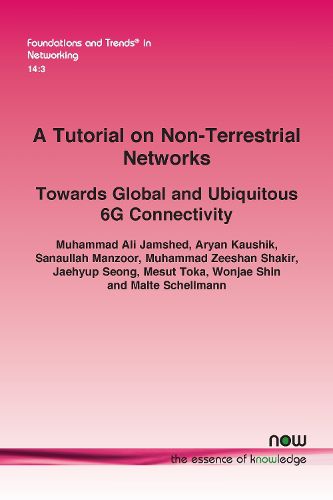Readings Newsletter
Become a Readings Member to make your shopping experience even easier.
Sign in or sign up for free!
You’re not far away from qualifying for FREE standard shipping within Australia
You’ve qualified for FREE standard shipping within Australia
The cart is loading…






The International Mobile Telecommunications (IMT)-2030 framework recently adopted by the International Telecommunication Union Radio Communication Sector (ITU-R) envisions 6G networks to deliver intelligent, seamless connectivity that supports reliable, sustainable, and resilient communications. To achieve this vision, Non-Terrestrial Networks (NTN) represent a significant advancement by extending connectivity beyond the Earth's surface. These networks integrate advanced communication technologies that go beyond conventional terrestrial infrastructure, enabling comprehensive global connectivity across domains such as the Internet, Internet of Things (IoT), navigation, disaster recovery, remote access, Earth observation, and even scientific initiatives like interplanetary communication.
Recent developments in the 3rd Generation Partnership Project (3GPP) highlight the critical role NTN is set to play in the evolution of 6G standards. The integration of advanced signal processing, edge and cloud computing, and Deep Reinforcement Learning (DRL) for Low Earth Orbit (LEO) satellites and aerial platforms, such as Uncrewed Aerial Vehicles (UAV) and high-, medium-, and low-altitude platform stations, has revolutionized the convergence of space, aerial, and Terrestrial Networks (TN). Artificial Intelligence (AI)-powered deployments for NTN and NTN-IoT, combined with Next Generation Multiple Access (NGMA) technologies, have dramatically reshaped global connectivity.
This monograph provides a comprehensive exploration of emerging NTN-based 6G wireless networks, covering vision, alignment with 5G-Advanced and 6G standards, key principles, trends, challenges, real-world applications, and novel problem solving frameworks. It examines essential enabling technologies like AI for NTN (LEO satellites and aerial platforms), DRL, edge computing for NTN, AI for NTN trajectory optimization, Reconfigurable Intelligent Surfaces (RIS)-enhanced NTN, and robust Multiple-Input-Multiple-Output (MIMO) beamforming. Furthermore, it addresses interference management through NGMA, including Rate-Splitting Multiple Access (RSMA) for NTN, and the use of aerial platforms for access, relay, and fronthaul/backhaul connectivity.
$9.00 standard shipping within Australia
FREE standard shipping within Australia for orders over $100.00
Express & International shipping calculated at checkout
The International Mobile Telecommunications (IMT)-2030 framework recently adopted by the International Telecommunication Union Radio Communication Sector (ITU-R) envisions 6G networks to deliver intelligent, seamless connectivity that supports reliable, sustainable, and resilient communications. To achieve this vision, Non-Terrestrial Networks (NTN) represent a significant advancement by extending connectivity beyond the Earth's surface. These networks integrate advanced communication technologies that go beyond conventional terrestrial infrastructure, enabling comprehensive global connectivity across domains such as the Internet, Internet of Things (IoT), navigation, disaster recovery, remote access, Earth observation, and even scientific initiatives like interplanetary communication.
Recent developments in the 3rd Generation Partnership Project (3GPP) highlight the critical role NTN is set to play in the evolution of 6G standards. The integration of advanced signal processing, edge and cloud computing, and Deep Reinforcement Learning (DRL) for Low Earth Orbit (LEO) satellites and aerial platforms, such as Uncrewed Aerial Vehicles (UAV) and high-, medium-, and low-altitude platform stations, has revolutionized the convergence of space, aerial, and Terrestrial Networks (TN). Artificial Intelligence (AI)-powered deployments for NTN and NTN-IoT, combined with Next Generation Multiple Access (NGMA) technologies, have dramatically reshaped global connectivity.
This monograph provides a comprehensive exploration of emerging NTN-based 6G wireless networks, covering vision, alignment with 5G-Advanced and 6G standards, key principles, trends, challenges, real-world applications, and novel problem solving frameworks. It examines essential enabling technologies like AI for NTN (LEO satellites and aerial platforms), DRL, edge computing for NTN, AI for NTN trajectory optimization, Reconfigurable Intelligent Surfaces (RIS)-enhanced NTN, and robust Multiple-Input-Multiple-Output (MIMO) beamforming. Furthermore, it addresses interference management through NGMA, including Rate-Splitting Multiple Access (RSMA) for NTN, and the use of aerial platforms for access, relay, and fronthaul/backhaul connectivity.